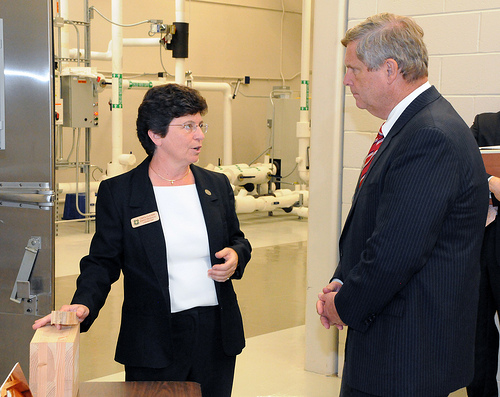
Amongst the falling leaves, you might discover the frost flowers of dittany (Cunila origanoides). Its former light blue flowers have come and gone, its seed cast to the wind, but from the base of their stems you may be lucky enough to see what looks like curling ribbons of ice, one last gem of their blooming glory, a frost flower. Courtesy of Kathy Phelps.
Fall is a wonderful time to find an amazing array of wildflowers on your national forests and grasslands. But before you venture out, take a moment for a sneak preview on the U.S. Forest Service’s Fall Colors web site for a few ideas to plan your visit
Early morning hikers who are out and about in the hardwood forests of the south-central and eastern United States may be lucky enough to observe the second flowering of dittany (Cunila origanoides). Also known as frost flowers, they are found in late autumn on crisp, frosty mornings. Though they are not true flowers, they are just as beautiful. Read more »

Research Microbiologist Carol Clausen discusses wood durability and protection research with Agriculture Secretary Tom Vilsack during his visit to the Forest Products Laboratory.
The Forest Products Laboratory (FPL) recently guided USDA Secretary Tom Vilsack through its unique set of research facilities. Basic and applied research at FPL supports a number of objectives, including forest management and restoration, the wise use of forest resources, job creation, and expanding economic opportunities through public-private partnerships on a national scale.
Throughout his tour, Secretary Vilsack talked with lab leadership about FPL’s diverse and innovative research efforts. Project leaders used the opportunity to field questions from the Secretary and explain work ranging from wood preservation and durability to advances in “green” building strategies and technology, use of beetle-killed trees, work on historic timber bridges, and advances in nanocellulose-related materials and applications. Read more »

The Elkwater Fork Dam with fall foliage. A paved accessible fishing area below the dam provides an area for those with physical impairments to fish in the stilling basin.
In 1993, several towns in Upper Tygart Valley Watershed in Randolph County, W.Va., experienced a dangerous shortage of water. At a critical point, the water plant was within 72 hours of completely running out of water. Soon after that, local community groups, interested citizens and government agencies began working toward a solution to avoid future water shortages.
The solution they ultimately settled on was to build a dam on the Elkwater Fork of the Tygart River. The dam would create a new reservoir that would provide a dependable water source for the 27,000 people in the watershed. Read more »
For many producers and rural communities, the summer of 2012 has been defined by a record drought.
From the early days of this disaster, USDA has taken action to help. We’ve streamlined our disaster designation process, provided easier access to farm credit, opened more conservation lands for emergency haying and grazing, and much more.
Meanwhile, we continue to convene regular meetings of White House Rural Council to coordinate the Federal response and identify every effort we can take to provide additional help and assistance.
For example, the Small Business Administration and National Credit Union Administration have worked to increase emergency lending for small businesses. The Department of Interior has opened more Federal land for grazing. The Department of Transportation has taken measures to get more trucks on the road in the relief effort. And the U.S. Army Corps of Engineers is working to preserve navigation routes on drought-stricken waterways. Read more »
Late last month Mississippi USDA Rural Development State Director Trina George attended the Kilmichael Clinic opening ceremony. The event celebrated the clinic’s completion and provided opportunities to tour the new facility. There was a great turnout and everyone was thrilled to see the new building, which has nine examination rooms and a waiting room to accommodate 40 people.
The Kilmichael project received a $1.4 million loan from USDA Rural Development’s Community Facilities Program in 2009. The Community Facility loan was obtained to construct a new clinic to provide health care services for the citizens of the Town of Kilmichael, Montgomery County, and the surrounding rural communities. “Kilmichael Hospital has been serving this community for decades,” said State Director George. “So when the opportunity came to award funding to construct a new healthcare clinic, I knew this would be a great service to this community and to this organization.” Read more »
Fabian Garcia, a U.S. Forest Service employee for eight years, intimately understands the connection between nature and nurture.
As a young Latino growing up in an agricultural community in central California, Garcia’s world revolved around the outdoors. When he, his parents and three siblings were not working, they were fishing in nearby lakes and streams, exploring giant sequoias that towered over forests or traveled just to play in the snow.
Today, Garcia, who is now 31, works with high school students in Los Angeles as director of the Southern California Consortium – the Forest Service conduit that helps young people connect to nature. His job has helped him to understand how his childhood connection to nature gave him peace of mind and eagerly shares his experiences with others. Read more »



